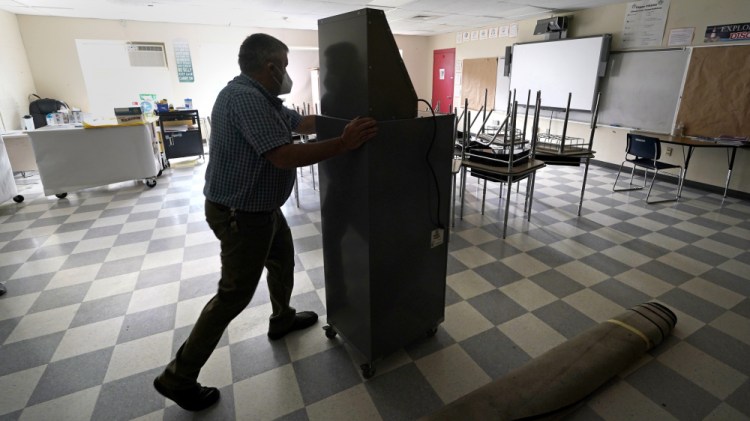As the federal government releases historic sums of pandemic aid to the nation’s schools, it’s urging them to dream big and invest in seismic changes that will benefit students for generations to come. But many districts say they have more urgent problems to tackle first.
In Detroit, that means fixing buildings with crumbling ceilings and mold infestations. Like other school systems, Detroit is caught between the Biden administration’s lofty aspirations and bleak realities. The district is using some of the government money to hire tutors, expand mental health services and cut class sizes. But at least half of its $1.3 billion windfall is being set aside to make long-neglected repairs.
“For decades, we have been inequitably funded to deal with the enormous needs that poverty and racial injustice have created in our city,” Superintendent Nikolai Vitti told The Associated Press in an interview. “Now with the COVID relief, we’re going to be able to put a significant dent into the challenge.”
The administration has encouraged schools to take leaps, not steps, with the funding. Education Secretary Miguel Cardona has called it a time for bold innovation that breaks down inequities and rethinks all aspects of schooling.
Despite those lofty aspirations, many large, urban districts are putting much of their pandemic relief toward practical needs, such as hiring nurses, restocking libraries, fixing playgrounds and bringing back art classes.
So far, there’s little evidence of major change, said Marguerite Roza, director of the Edunomics Lab, a school finance think tank at Georgetown University. Part of the problem, she said, is that the aid was given to schools with few strings attached.
“That’s not a recipe for innovation,” Roza said. “We sprinkled the dollars as blank checks to every one of these districts. And many are going to do what they already know how to do.”
The infusion of pandemic relief is bigger than anything American schools have seen before. It totals $190 billion, more than four times the amount the Education Department spends on K-12 schools in a typical year.
Congress has sent the funding in three waves since the start of the pandemic. The latest and largest round, which totals $123 billion, is still being distributed and gives school enormous flexibility in how to spend it.
Yet little is being done to track how schools are using the money. After the first wave of funding, the Education Department’s internal watchdog warned that grant oversight has been a “persistent management challenge.” It cautioned that internal weaknesses could limit the department’s ability to monitor the funding.
The Associated Press, relying on data published or provided by states and the federal government, for the first time tallied how much money was granted to nearly every district in the country. The AP tracked more than $155 billion sent to states to distribute among schools since last year, including general pandemic relief that some states shared with their schools.
The aid averages nearly $2,800 per student, but it varies widely by district and state, according to the AP’s analysis. High-poverty areas received much more under the funding formula. Detroit received the highest rate among big districts, at more than $25,000 per student.
Schools have three years to spend the latest round, a window that districts say is short for such a large amount of money. In many areas, school officials are reluctant to take on costs they may not be able to sustain after the federal aid is gone.
In St. Paul, Minnesota, the public school system is getting $321 million in total funding, an amount that Superintendent Joe Gothard calls “jaw-dropping.” But he said the time frame limits his spending options. The district has hired some new teachers, but it’s mostly focusing on one-time costs such as building renovations and replacing library books.
“Three years will come very fast,” Gothard said. “It’s about managing expectations, honestly, and it starts with myself. We really have to be careful about avoiding a financial cliff.”
Districts across the U.S. have spent the summer debating how to spend the new money, in some cases facing pressure from competing groups of parents and activists.

A summer school student is tested for COVID-19 in the nurse’s office at the E.N. White School in Holyoke, Mass., on Aug. 4, 2021. Charles Krupa/Associated press
Some families want more money to go to special education. Others have demanded teacher training to address racial bias. At the same time, districts face mounting pressure to increase teacher salaries.
Eyeing the district’s $300 million in pandemic aid, the teachers union in Sacramento, California, called for smaller class sizes, which would mean hiring new teachers, along with pay increases. And while the union is not asking to tap into federal money for raises, the mere existence of the windfall bolsters the contention that raises are affordable.
Another source of concern for schools is state funding. While the worst fears of education cuts have not come to pass, there’s worry that the infusion of federal money will provide a reason to slash future state budgets.
In Detroit, Vitti sees a chance to make the case for more state funding. He hopes to prove that even the one-time funding will help boost graduation rates, cut absenteeism and lead to tangible improvements for students. If he can do that, he hopes lawmakers in Lansing will offer him a continued lifeline to keep up the success.
“We’re looking forward to show clear outcomes from this investment,” he said, to make the case that similar funding “should be continued in an equitable way.”
Associated Press Writer Corey Williams in Detroit contributed to this report.
Send questions/comments to the editors.



Comments are no longer available on this story